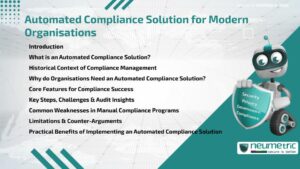Table of Contents
ToggleIntroduction
Higher Education Institutions face growing demands to protect Sensitive Data & ensure Compliance with Regulations. The Higher Education Community Vendor Assessment Toolkit [HECVAT] is a standardised tool designed to evaluate Vendor Risks. With the release of HECVAT 4, Institutions can conduct Gap Audits to uncover Compliance shortcomings. This article explains what a HECVAT 4 Gap Audit is, why it matters & how Universities & Colleges can apply Best Practices to strengthen Security & Compliance.
Understanding HECVAT & Compliance in Higher Education
HECVAT provides a consistent method for evaluating Vendors who access or manage Institutional Data. It helps Universities ensure that Third Party Services meet Compliance Requirements such as FERPA & GDPR. Compliance in Higher Education is complex, with Institutions balancing Academic freedom, Data Privacy & Regulatory obligations. HECVAT simplifies these processes by standardising Vendor Assessments.
What is a HECVAT 4 Gap Audit?
A HECVAT 4 Gap Audit is the process of comparing an Institution’s current Vendor Risk Management practices against the requirements & recommendations in HECVAT 4. The Audit highlights areas where Policies, Procedures or Vendor oversight may fall short of Compliance or Best Practices. It acts as a Roadmap for improvement, guiding Institutions to close Gaps before they lead to Risks.
Why conduct a HECVAT 4 Gap Audit?
Conducting a HECVAT 4 Gap Audit is crucial for identifying weaknesses that could compromise Compliance or Data Security. Without such an Audit, Institutions Risk Non-Compliance Penalties, Reputational damage & Data Breaches. A structured Audit ensures Accountability, Transparency & proactive Risk Management.
Best Practices for performing a HECVAT 4 Gap Audit
To maximise results, Institutions should follow structured Best Practices:
- Set Clear Objectives: Define what the Audit aims to uncover, such as Compliance Gaps or Security weaknesses.
- Assemble a Skilled Team: Involve IT Staff, Compliance Officers & Procurement Teams.
- Evaluate Vendor Categories: prioritise Vendors based on their access to Sensitive Data.
- Document Findings Thoroughly: Maintain clear records of shortcomings for Reference & Remediation.
- Implement Corrective Actions: Develop Policies & training to close identified Gaps.
- Review & Update Regularly: Conduct Audits periodically to stay aligned with evolving Risks.
Common Challenges during a HECVAT 4 Gap Audit
Institutions may face obstacles such as lack of Staff expertise, difficulty interpreting Vendor responses or limited Cooperation from Vendors. Smaller Institutions might find it challenging to allocate Resources to thorough Audits. In some cases, the sheer volume of Vendors can make the process time-consuming.
Benefits of identifying Compliance Shortcomings
The primary benefit of a HECVAT 4 Gap Audit is stronger Compliance & reduced Risk. Institutions can address issues before they escalate, improve Vendor relationships & demonstrate Accountability to Stakeholders. Identifying Compliance shortcomings also enhances trust among Students, Faculty & Regulatory bodies.
Comparing HECVAT 4 Gap Audits with Other Assessment Methods
While general Audits such as ISO 27001 or SOC 2 Assessments provide valuable insights, they are not tailored to Higher Education. A HECVAT 4 Gap Audit directly addresses the unique challenges of Academic Institutions, making it more relevant & actionable for Universities & Colleges.
Final Thoughts
A HECVAT 4 Gap Audit is a vital tool for uncovering Compliance shortcomings in Higher Education. By following Best Practices & addressing challenges, Institutions can ensure Data Security, Regulatory Compliance & stronger Vendor management.
Takeaways
- A HECVAT 4 Gap Audit highlights Compliance shortcomings in Vendor Risk Management.
- Best Practices include clear Objectives, skilled Teams & thorough Documentation.
- Regular Audits improve Compliance, strengthen Vendor partnerships & reduce Risks.
FAQ
What is the purpose of a HECVAT 4 Gap Audit?
Its purpose is to identify areas where an Institution’s Vendor Risk Management practices do not align with HECVAT 4 requirements.
How often should a HECVAT 4 Gap Audit be conducted?
Institutions should conduct Gap Audits annually or when significant changes occur in Regulations or Vendor relationships.
Who should be involved in a HECVAT 4 Gap Audit?
A Multidisciplinary Team including IT Staff, Compliance Officers & Procurement personnel should participate.
What challenges can arise during a HECVAT 4 Gap Audit?
Challenges include Vendor reluctance, complex Technical answers & limited Staff expertise.
How does a HECVAT 4 Gap Audit differ from an ISO or SOC 2 Audit?
HECVAT 4 Audits are tailored to Higher Education, while ISO & SOC 2 Audits are broader Industry frameworks.
Can Small Colleges perform a HECVAT 4 Gap Audit effectively?
Yes, but they may need to prioritise Vendors with high data access & collaborate with Consortia to share insights.
Need help for Security, Privacy, Governance & VAPT?
Neumetric provides organisations the necessary help to achieve their Cybersecurity, Compliance, Governance, Privacy, Certifications & Pentesting needs.
Organisations & Businesses, specifically those which provide SaaS & AI Solutions in the Fintech, BFSI & other regulated sectors, usually need a Cybersecurity Partner for meeting & maintaining the ongoing Security & Privacy needs & requirements of their Enterprise Clients & Privacy conscious Customers.
SOC 2, ISO 27001, ISO 42001, NIST, HIPAA, HECVAT, EU GDPR are some of the Frameworks that are served by Fusion – a SaaS, multimodular, multitenant, centralised, automated, Cybersecurity & Compliance Management system.
Neumetric also provides Expert Services for technical security which covers VAPT for Web Applications, APIs, iOS & Android Mobile Apps, Security Testing for AWS & other Cloud Environments & Cloud Infrastructure & other similar scopes.
Reach out to us by Email or filling out the Contact Form…





